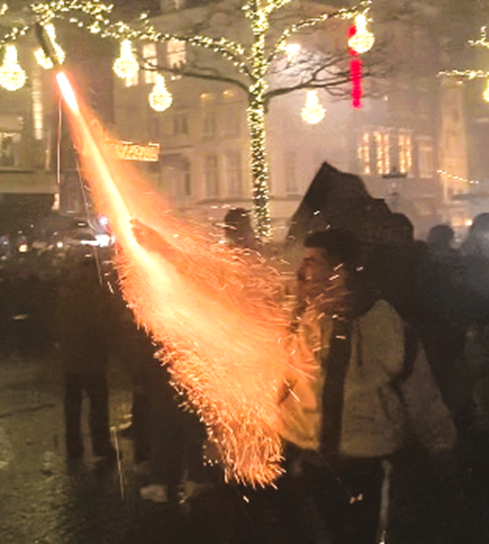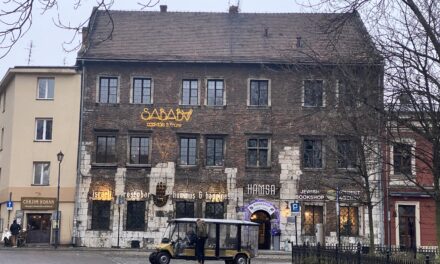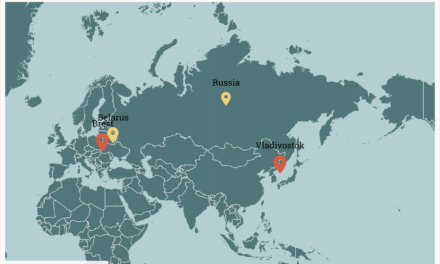In recent years, the tranquil skies above the picturesque island of Malta have been marred by a series of explosive incidents, leaving residents and authorities grappling with a serious fireworks problem. The once joyous celebrations have taken a dangerous turn, raising concerns about public safety, property damage, and the long-term impact on the island’s cultural traditions.
Research carried out by Edward Attard shows that in the past century, 169 persons, including nine children, died in explosions caused by fireworks in Malta, with an average of 2.2 lives lost per year between 1980 and 2010. These accidents occurred either in the workshops where the fireworks were being manufactured, when they were being transported, or when being let off.
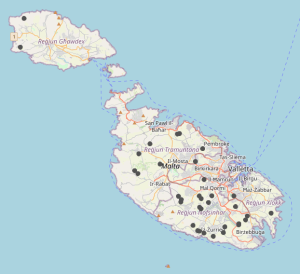
map of the 35 factories in Malta, 2015 statistics from Malta Spatial Data Infrastructure.
Malta’s festas, synonymous with spectacular fireworks displays, have been a staple for over a 100 years. While the origins of pyrotechnics date back to the East, Malta has distinguished itself as a global player in the industry, winning international accolades and hosting renowned festivals. However, the darker side of this tradition has come to the fore, with accidents claiming lives and environmental pollution posing health risks. The once-thriving industry, with 39 fireworks factories in 2007, now grapples with a decline, amplified risks, and a pressing need for regulatory reforms.
The malaise began to escalate in 2010, a year that witnessed a record number of deaths caused by pyrotechnics, earning Malta the unenviable position of being second only to China in fireworks fatalities for that year. The decline in the number of factories since 2007, coupled with an increased demand for fireworks, has led to a concentration of production, resulting in more stored pyrotechnics on-site. The tragic 2010 explosion in Gharb, which claimed six lives, was caused by the storing of large quantities of fireworks in a single location, the explosion being felt across the entire island, and even heard on the southern coast of Sicily.
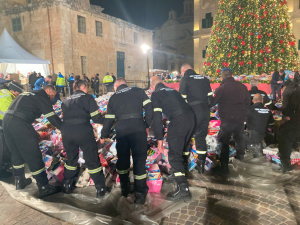
Firefighters wrapping Christmas gifts in a special foil to ensure any firework residue doesn’t set them on fire.
Compounding the issue is the quality of imported chemicals, often sourced from distributors in India, Mexico, and China. Despite certificates of origin and quality, local analysis of these chemicals is notably absent. A government-appointed board of inquiry is delving into the quality of materials used and practices related to chemical mixing, as a step toward mitigating future risks.
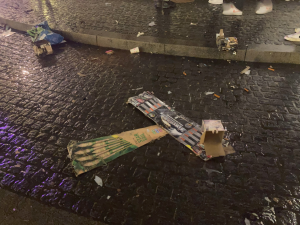
Firework trash strewn about Valletta.
After a lengthy interview with Renato Camilleri, a firework expert and lecturer at the University of Malta, it became clear that the issue was not as simple as it seemed. Beyond the immediate threats of explosions, Malta faces a silent menace – pollution. A comprehensive study by Renato Camilleri and his colleagues revealed that airborne dust, laden with hazardous particulate matter, spikes during festa celebrations, contributing to a year-round air quality concern. Perchlorate, a chemical used in fireworks, permeates Malta’s water sources, presenting health risks, such as cancer, particularly to children. Despite these findings, public attention remains fixated on the sensational explosions, overshadowing the pervasive and long-term risks posed by pollution. “There is no control on the waste management from the fireworks, so all the papers, all the equipment that’s contaminated with the toxic mixtures, there is no control on how this is disposed of. Some of it is bent, some of it is disposed of normally. Most of these factories are located in rural areas. They are located next to fields. Possibly some toxic waste is dumped close to these fields and they will contaminate the soil, and eventually the surrounding soils as well” said Mr. Camilleri.
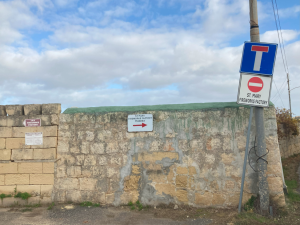
Two fireworks factories on the outskirts of a small village.
When we think of factories, we may imagine large industrial buildings, but the firework factories in Malta are the exact opposite to this stereotypical image. Renato Camilleri described them as such – “These are not sort of proper manufacturing plants which have to go through all the permits, get qualified chemists, the IPC permits, the pollution prevention control permits, etc. These are typically sheds in rural areas. And they are run by volunteers. They are, of course, licensed, but it’s not something that is full-time or professional.”
To understand the root of Malta’s fireworks conundrum, it’s essential to delve into the historical and cultural aspects that have contributed to the current situation. Fireworks have played a significant role in Maltese celebrations for centuries, symbolizing joy, triumph, and religious devotion. The use of pyrotechnics in Malta is deeply ingrained in the cultural fabric, with fireworks festivals serving as a focal point for communal gatherings. Around 102 villages and towns celebrate a Festa every year, sometimes even twice a year, with each village spending an average of 12,000$ on fireworks alone in preparation for the celebrations. The demand for grander, more spectacular displays has led to the introduction of powerful fireworks, such as the petard fired in September of 2016, weighing 260kg (the average petard weighs only 3kg) and 3 meters wide, made entirely by a local volunteer. This relentless pursuit of excitement has created a precarious environment where safety often takes a back seat to tradition.
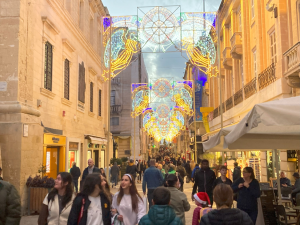
Maltese people in the city markets.
Malta’s love affair with fireworks is deeply rooted in its cultural and religious traditions. Festivals and religious processions, such as those dedicated to local saints, are accompanied by elaborate fireworks displays. The breathtaking bursts of color and sound are considered expressions of joy, devotion, and community spirit. Additionally, the competitive nature of these displays has fueled a desire for more extravagant pyrotechnics, driving a lucrative industry that has become deeply intertwined with the Maltese way of life. Introduced by the Order of St. John in the 1600s, the art of pyrotechnics has evolved into an integral part of Maltese identity. In 2023 UNESCO added the Maltese Festa to its list of intangible cultural heritage, which only solidified the position of fireworks in the eyes of the public. “That was real stupid. It was already so hard to get even a single law through about limiting fireworks, and now it’s just impossible. No new laws are gonna be introduced anymore” said a disappointed local, Kurt Baldachino.
As Malta stands at this critical juncture, the preservation of its pyrotechnic tradition may necessitate a reckoning with safety and environmental responsibility. Stringent regulations, frequent inspections, and high-quality chemical assurance are pivotal to ensuring the safety of both enthusiasts and the public. But what can be done to limit the number of risks without outright banning fireworks? Renato Camilleri mentioned the possibility of using green compositions to create fireworks, which produce a very limited amount of toxic gas, as well as release a minuscule portion of fine particulate matter, compared to what normal fireworks produce. The biggest issue with this, however, is the fact that green compositions are very expensive and hard to produce. Another solution that was already put in place in 2012 was the banning of potassium chlorate in the manufacture of fireworks. In its stead, manufacturers now use potassium perchlorate, a much less reactive chemical. But Renato Camilleri mentions that even this isn’t a solution without downsides “Potassium perchlorate has its environmental problems as well. It lingers in the air, produces dust, and even gets in the water. The chemical is an antithyroid, in large amounts it causes thyroid cancer. So there’s a safety benefit to the manufacturers because they are working with safer compositions. But then there is the environmental impact as well.”
It seems increasingly difficult to find a solution that is agreeable to every side. Firework enthusiasts will always oppose banning fireworks, while many others are fed up with the dangers that fireworks pose to their lives. The only truly viable solution all sides may agree on is limiting the amount of fireworks. “What we’ve seen is quite an increase in the number of fireworks and the quantity of fireworks. By limiting fireworks you automatically would be decreasing the quantity of the dust, and the pollutants produced from the combustion process. We need to also decrease the quantity of certain chemicals, other chemicals that are particularly toxic to the environment, like for example, antimony and barium,” said Mr. Camilleri.
However, as Malta grapples with the escalating problem, no long term changes seem to be making headway. While many acknowledge the need for stricter regulations and enhanced safety measures, the deeply entrenched cultural significance of fireworks complicates the implementation of effective reforms. Proposals for tighter regulations often face resistance from various quarters, with some arguing that any restriction on fireworks would undermine Malta’s unique identity and cultural heritage. Despite the growing urgency, politicians are finding it difficult to strike a balance between preserving tradition and addressing the inherent dangers associated with fireworks.
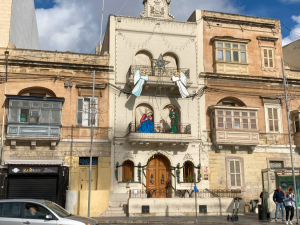
Malta is a deeply religious country, with fireworks playing a large part in celebrating religious festivals. Many buildings can be seen across the island with religious symbols.
A proposal by Labour MP Anton Refalo in 2018 to ban fireworks was immediately shot down. Not only is reform being hindered, but previously passed reforms are also being changed. In 2019 all the Members of the Maltese Parliament unanimously changed the law, allowing fireworks factories to be built less than the distance stipulated by law. What this meant was that fireworks factories were now permitted to be closer to populated areas and public roads. The Planning Authority’s push for a development notification order (DNO) to retroactively legalize factories adds another layer of uncertainty. The DNO greenlit every factory on the island, no matter their distance to residential areas. The palpable grip of the fireworks lobby on politicians, cutting across party lines, raises questions about the impartiality of legislative decisions when it comes to pyrotechnics.
To understand just how powerful the fireworks lobby is, we must put into perspective that there are around 2000 licensed fireworks enthusiasts in Malta, with every village having its own fireworks club and cities having multiple, the leadership of these villages closely tied to the clubs. “The clubs make sure to have the politicians in their pocket, you know? They give them special positions, or even the highest position, so the politician starts working for them, instead of against them. Oh, and it doesn’t even matter what party the politician is from. Leftist, rightist, socialist, nationalist, democrat, they don’t discriminate” said a much more impassioned Kurt. It seems that fireworks are a bipartisan issue, as demonstrated by the unanimous votes to pull back regulations in 2019. With just how much voting power the firework enthusiasts possess, most politicians are not truly willing to side against them and ruin any chance of being reelected.
50,000 people gathered in the capital of Malta, Valetta, to celebrate Christmas this year. Fireworks had been going off the entire week beforehand, throughout the day and the night, increasing in intensity as Christmas day neared. When the clock struck midnight, more fireworks went off at once than I had ever seen before. Every village, every town, and every city on the island was shooting hundreds
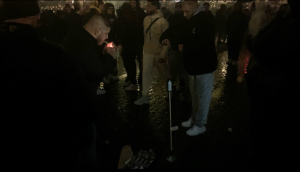
man smoking a cigarette, before shooting off a firework.
of fireworks a minute. People on the rooftops and balconies of apartments, people on boats, and people in the streets all fired off into the air, turning the night sky almost as bright as during the day. It was a truly beautiful sight, but the sound was deafening. I remembered the words of an Indian expat, Paru Chaula, that I interviewed a few days prior “I don’t go out during Christmas or New Year’s, or for Festas. I love Malta and the people here but when it comes to fireworks I will never participate. It scares my dog, it scares my daughter, it scares me too!” There were a few close calls with some not taking sufficient precautions, like not holding a burning rocket-shaped firework in their hands, but the night progressed surprisingly without incident.
After the fireworks finally started calming down at 2 am, the smell of gunpowder settled over the city. Despite the warm weather (partly thanks to the thousands of fireworks exploding across the island), many could be heard coughing, while others covered their ears from the pain. All in all, a spectacular and beautiful sight, but Maltese people need to start asking themselves if beauty is worth their lives.
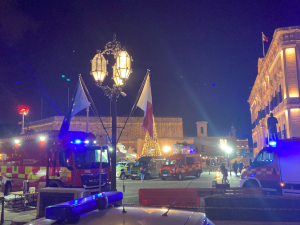
firefighters and police were on standby almost every night leading up to Christmas, with their numbers increasing exponentially on the holiday itself.
